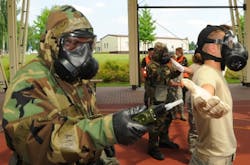QinetiQ to continue research on Army air- and missile-defense network-centric computer designs
Since the A3P contract was awarded, Elmco Corp. was acquired by Westar Aerospace & Defense Group Inc. in St. Louis, which subsequently was acquired by QinetiQ North America. The Army thus far has spent about $20 million on the A3P contract, and QinetiQ -- through its acquisitions -- has more than five years of experience on the program.
AMRDEC officials are hiring QinetiQ for engineering expertise to develop advanced warfighting concepts using integrated networking and fire-control.
Architectures to be involved in the current program include the Surface-Launched Advanced Medium-Range Air-to-Air Missile (SLAMRAAM) and other air- and missile-defense technology to defend against cruise missiles; unmanned aerial vehicles (UAVs); helicopters and fixed-wing aircraft; rockets, mortars, and artillery shells; short-, medium, intermediate, and intercontinental-range ballistic missiles, and other ground-attack weapons.
Army researchers say QinetiQ is the only company qualified to provide these kinds of services, based on the company's unique and immediately-available architecture expertise, as well as the company's domain knowledge of air- and missile-defense system components such as SLAMRAAM, Army officials say.
AMRDEC SED wants to use existing knowledge and tools to analyze different air- and missile-defense systems designs. Among the QinetiQ's relevant tools are the Distributed Integrated Air and Missile Defense Simulator, better-known as DIAMDS; Real-Time DIAMDS; the Intelligence Situational Awareness Tool (ISAT); Tactical Data Generator (TDG); Mission Rehearsal Tool (MRT); Trajectory Design Tool (TDT); the Route Planning Tool (RPT); Data Analysis and Reduction Tool (DART); and the ViewPoint animation and visualization tool.
For more information contact QinetiQ North America online at www.qinetiq-na.com, or the Army Aviation and Missile Research, Development, and Engineering Center at www.redstone.army.mil/amrdec.
